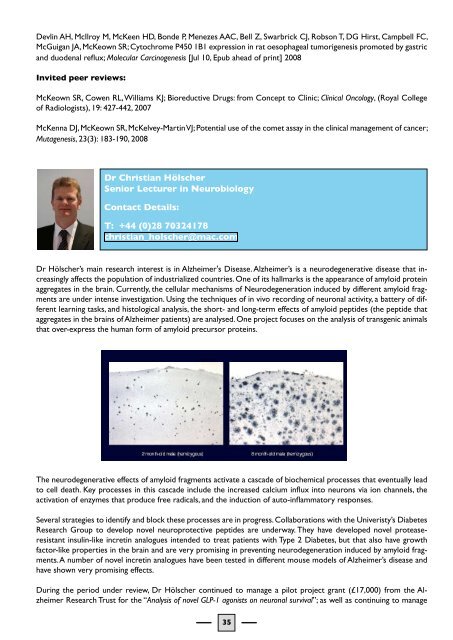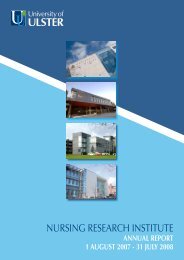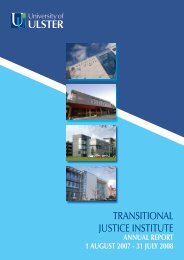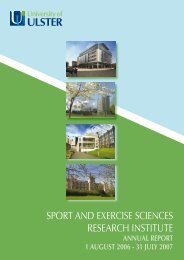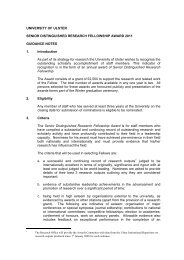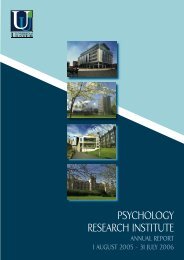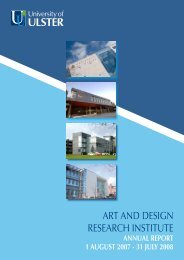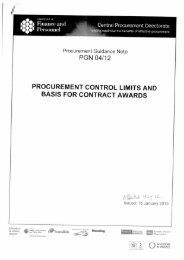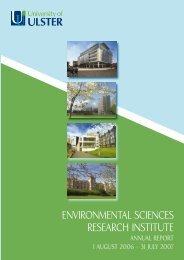Pr<strong>of</strong>essor Stephanie McKeownPr<strong>of</strong>essor <strong>of</strong> Cancer BiologyContact Details:T: +44 (0)28 70323542sr.mckeown@ulster.ac.ukPr<strong>of</strong>essor McKeown’s main area <strong>of</strong> interest is tumour biology with particular reference to hypoxia and bioreductivedrugs, and their combination with radiotherapy and chemotherapy.Tumour hypoxia is a critical feature <strong>of</strong> many solid tumours and is known to reduce the efficacy <strong>of</strong> both radiotherapyand chemotherapy. Bioreductive drugs are designed to specifically target hypoxic cells and can be used to treat solidtumours to enhance the effects <strong>of</strong> standard therapies. This class <strong>of</strong> cytotoxic agent is particularly useful as it is designedto be administered as a non-toxic prodrug. It becomes cytotoxic in hypoxic cells and therefore causes limitedsystemic toxicity since the cytotoxic species is only produced in areas <strong>of</strong> hypoxia i.e. primarily in tumours. In collaborationwith Pr<strong>of</strong>essor LH Patterson (Director, Institute <strong>of</strong> Cancer Therapeutics, <strong>University</strong> <strong>of</strong> Bradford) our work hasdemonstrated that AQ4N (Banoxantrone) is the best bioreductive drug available. Pre-clinical studies carried out atthe <strong>University</strong> <strong>of</strong> <strong>Ulster</strong> have provided convincing evidence <strong>of</strong> the efficacy <strong>of</strong> AQ4N and further supporting evidencehas come from several other groups world-wide. Clinical trials <strong>of</strong> AQ4N combined with radiotherapy and chemotherapyare ongoing in both the UK and USA (reviewed in an invited paper indicated below).This year we have identified novel responses to the treatment <strong>of</strong> tumours which indicate that we need to moreclearly understand what occurs in the initial days after treatment with a number <strong>of</strong> drugs. There are several consequences<strong>of</strong> these studies which are currently not clearly recognised in the scientific community. We plan to use ourknowledge to develop new ‘informed schedules’ and test them for efficacy. In addition we plan to follow the biological/ molecular consequences <strong>of</strong> these changes. A greater understanding <strong>of</strong> these changes could lead to the design <strong>of</strong>more effective ways to eradicate solid tumours.Pr<strong>of</strong>essor McKeown is currently the <strong>University</strong> <strong>of</strong> <strong>Ulster</strong>’s Designated Individual (DI) as described under the HumanTissue Act (2004). In this capacity she oversees all <strong>of</strong> the activities relating to storage and use <strong>of</strong> human tissues usedprimarily for <strong>research</strong> within the <strong>University</strong> and its associated sites. She is also the Chairperson <strong>of</strong> the Irish Radiation<strong>Research</strong> Society (and co-organiser <strong>of</strong> its scientific meeting in Dublin, October 2007) and a member <strong>of</strong>: the BritishInstitute <strong>of</strong> Radiology (and its Cancer and Radiation Biology Committee); the National Cancer <strong>Research</strong> Institute,UK (and its Radiotherapy Trials Clinical Studies Group); the Council <strong>of</strong> the International Association for Radiation<strong>Research</strong>; the Ireland-Northern-Ireland-NCI-USA Cancer Consortium (and the Scientific Committee for its biennialmeeting in Dublin, 2008).Pr<strong>of</strong>essor McKeown has been the Chairperson <strong>of</strong> the Northern Ireland (NI) Cancer Recognised <strong>Research</strong> Groupsince 2007 as well as being the Treasurer to the NI Committee <strong>of</strong> the Institute <strong>of</strong> Biology since 2004. She has alsoacted as Radiobiology specialist examiner, for the Clinical Oncology examinations at the Royal College <strong>of</strong> Radiologistsin London and became an External Assessor for the <strong>University</strong> <strong>of</strong> Malaya, Kuala Lumpar in 2008.Publications:Butterworth KT, McCarthy HO, Devlin A, Ming L, Robson T, McKeown SR, Worthington J; Hypoxia selects for androgenindependent LNCaP cells with a more malignant genotype and phenotype; International Journal <strong>of</strong> Cancer, 123: 760-768, 2008O’Keeffe MB, Devlin AH, Burns AJ, Gardiner TA, Logan ID, Hirst DG, McKeown SR; Investigation <strong>of</strong> pericytes, hypoxiaand vascularity in bladder tumours: association with clinical outcomes; Oncology <strong>Research</strong>, 17: 93-101, 2008O’Rourke M, Ward C, McKenna J, Worthington J, Valentine A, Hirst DG, McKeown SR; Evaluation <strong>of</strong> the anti-angiogenicpotential <strong>of</strong> AQ4N; Clinical Cancer <strong>Research</strong>, 14: 1502-1509, 200834
Devlin AH, McIlroy M, McKeen HD, Bonde P, Menezes AAC, Bell Z, Swarbrick CJ, Robson T, DG Hirst, Campbell FC,McGuigan JA, McKeown SR; Cytochrome P450 1B1 expression in rat oesophageal tumorigenesis promoted by gastricand duodenal reflux; Molecular Carcinogenesis [Jul 10, Epub ahead <strong>of</strong> print] 2008Invited peer reviews:McKeown SR, Cowen RL, Williams KJ; Bioreductive Drugs: from Concept to Clinic; Clinical Oncology, (Royal College<strong>of</strong> Radiologists), 19: 427-442, 2007McKenna DJ, McKeown SR, McKelvey-Martin VJ; Potential use <strong>of</strong> the comet assay in the clinical management <strong>of</strong> cancer;Mutagenesis, 23(3): 183-190, 2008Dr Christian HölscherSenior Lecturer in NeurobiologyContact Details:T: +44 (0)28 70324178christian_holscher@mac.comDr Hölscher’s main <strong>research</strong> interest is in Alzheimer's Disease. Alzheimer’s is a neurodegenerative disease that increasinglyaffects the population <strong>of</strong> industrialized countries. One <strong>of</strong> its hallmarks is the appearance <strong>of</strong> amyloid proteinaggregates in the brain. Currently, the cellular mechanisms <strong>of</strong> Neurodegeneration induced by different amyloid fragmentsare under intense investigation. Using the techniques <strong>of</strong> in vivo recording <strong>of</strong> neuronal activity, a battery <strong>of</strong> differentlearning tasks, and histological analysis, the short- and long-term effects <strong>of</strong> amyloid peptides (the peptide thataggregates in the brains <strong>of</strong> Alzheimer patients) are analysed. One project focuses on the analysis <strong>of</strong> transgenic animalsthat over-express the human form <strong>of</strong> amyloid precursor proteins.The neurodegenerative effects <strong>of</strong> amyloid fragments activate a cascade <strong>of</strong> biochemical processes that eventually leadto cell death. Key processes in this cascade include the increased calcium influx into neurons via ion channels, theactivation <strong>of</strong> enzymes that produce free radicals, and the induction <strong>of</strong> auto-inflammatory responses.Several strategies to identify and block these processes are in progress. Collaborations with the Univeristy’s Diabetes<strong>Research</strong> Group to develop novel neuroprotective peptides are underway. They have developed novel proteaseresistantinsulin-like incretin analogues intended to treat patients with Type 2 Diabetes, but that also have growthfactor-like properties in the brain and are very promising in preventing neurodegeneration induced by amyloid fragments.A number <strong>of</strong> novel incretin analogues have been tested in different mouse models <strong>of</strong> Alzheimer’s disease andhave shown very promising effects.During the period under review, Dr Hölscher continued to manage a pilot project grant (£17,000) from the Alzheimer<strong>Research</strong> Trust for the “Analysis <strong>of</strong> novel GLP-1 agonists on neuronal survival”; as well as continuing to manage35
- Page 1: BIOMEDICAL SCIENCESRESEARCH INSTITU
- Page 4 and 5: 1 Foreword by the Pro Vice-Chancell
- Page 6 and 7: 2 Foreword by the Research Institut
- Page 8 and 9: The BMSRI Research StructureThe BMS
- Page 10 and 11: BMSRI Core FacilitiesContact: Karen
- Page 12 and 13: of Metabolomics, pharmacy, nutritio
- Page 14 and 15: BMSRI Academic Heads new Regional N
- Page 16 and 17: 4. BIOMEDICAL GENOMICS RESEARCH GRO
- Page 18 and 19: Recent Funding Initiatives:C-TRIC:
- Page 20 and 21: Dr Mateus Webba da SilvaLecturer in
- Page 22 and 23: 5. BIOIMAGING RESEARCH GROUPResearc
- Page 24 and 25: developmental alterations that mani
- Page 26 and 27: Publications:Bigot S, Lucas L, Morr
- Page 28 and 29: Publications:Barnes CA, O’Hagan B
- Page 30 and 31: We also measure the genotoxic effec
- Page 32 and 33: 6. CANCER AND AGEING RESEARCH GROUP
- Page 34 and 35: Professor Anthony P McHaleProfessor
- Page 38 and 39: an Alzheimer Research Trust collabo
- Page 40 and 41: JM, Waugh DJJ; Dexamethasone potent
- Page 42 and 43: have wider applications in vivo, in
- Page 44 and 45: Inter-relationships between diet an
- Page 46 and 47: Flatt PR; Effective surgical treatm
- Page 48 and 49: These areas are the subject of seve
- Page 50 and 51: Dr YHA Abdel-WahabSenior Lecturer i
- Page 52 and 53: Dr VA GaultLecturer in Molecular Bi
- Page 54 and 55: McClean PL, Irwin N, Hunter K, Gaul
- Page 56 and 57: Publications:Duffy NA, Green BD, Ir
- Page 58 and 59: 8. MICROBIOLOGY AND BIOTECHNOLOGYRE
- Page 60 and 61: Publications:Graham RJL, Graham C,
- Page 62 and 63: analyses. However there is still a
- Page 64 and 65: Plessas S, Bekatorou A, Koutinas AA
- Page 66 and 67: Biochemical studies/ viral evasion
- Page 68 and 69: Dr Stephen McCleanLecturer in Prote
- Page 70 and 71: environmental remediation and as ro
- Page 72 and 73: 9. NORTHERN IRELAND CENTRE FOR FOOD
- Page 74 and 75: 26-28 Sept 2007: International Seaf
- Page 76 and 77: Dr Barnes has developed expertise i
- Page 78 and 79: Dr Alison GallagherSenior Lecturer
- Page 80 and 81: In addition, results of a pilot stu
- Page 82 and 83: Dr Maeve KerrResearch AssociateCont
- Page 84 and 85: Memberships of External Committees/
- Page 86 and 87:
Indicators of Esteem:Professor McNu
- Page 88 and 89:
were examined. The intervention and
- Page 90 and 91:
Within this work both short-term an
- Page 92 and 93:
micronutrient supplementation at a
- Page 94 and 95:
10. STEM CELL & EPIGENETICS RESEARC
- Page 96 and 97:
Publications:Lees-Murdock DJ, Lau H
- Page 98 and 99:
Publications:Lees-Murdock DJ, Lau H
- Page 100 and 101:
11. SYSTEMS BIOLOGY RESEARCH GROUPT
- Page 102 and 103:
Kravtsov V, Swain M, Schuster A, Du
- Page 104 and 105:
Dr Daniel BerrarLecturer in Biomedi
- Page 106 and 107:
Zhang et al; Incorporating Feature
- Page 108 and 109:
Bala P, Baldridge K, Benfenati E, C
- Page 110 and 111:
In addition there is a growing them
- Page 112 and 113:
Clinical work involves development
- Page 114 and 115:
In 2009 he was appointed Chairman o
- Page 116 and 117:
Stevenson TR, Goodall EA and Moore
- Page 118 and 119:
Dr Raymond BeirneLecturer in Optome
- Page 120 and 121:
Dr Julie McClellandLecturer in Opto
- Page 122 and 123:
Graham JE, Moore JE, Moore JE, McCl
- Page 124 and 125:
Research Staff:Dr David OrrSenior R
- Page 126 and 127:
Dr Victoria McGilliganResearch Asso
- Page 128 and 129:
13. Externally Funded Projects duri
- Page 130 and 131:
Grant Holder Anderson, Prof RSFundi
- Page 132 and 133:
Funding Body Royal Irish AcademyAmo
- Page 134 and 135:
14. BIOMEDICAL SCIENCES RESEARCH IN
- Page 136 and 137:
Student: Simon GenglerTitle: Effect
- Page 138 and 139:
Student: Anisha MazumdarTitle: Anal
- Page 140 and 141:
Student: Clare RyanTitle: How does
- Page 142 and 143:
CONGRATULATIONS TO THE FOLLOWING PO


